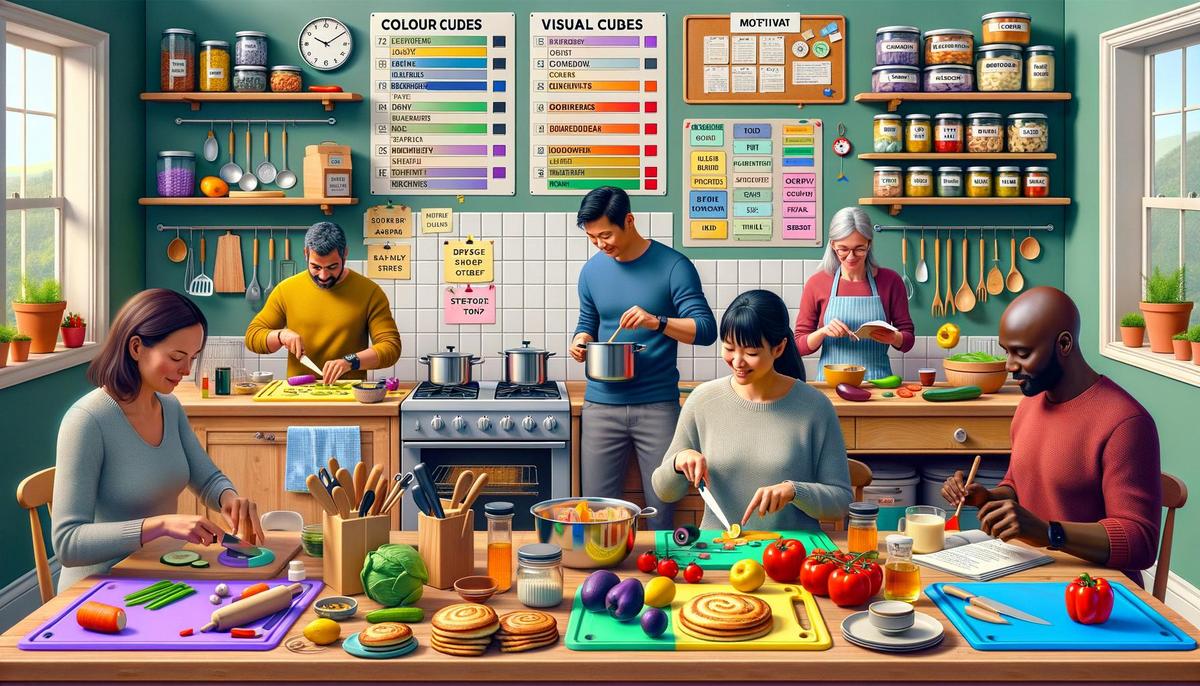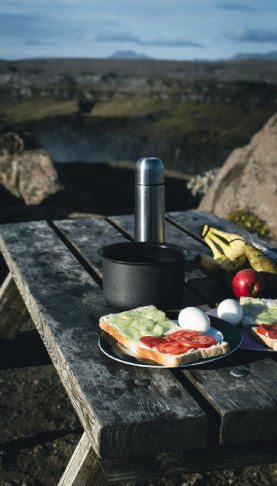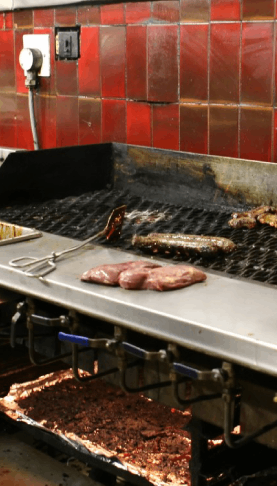If you love restaurants and your brain runs fast, ADHD friendly cooking looks like this: short prep sprints, one-pan meals, loud timers that do the remembering, simple flavor boosts that copy your favorite spots, and small systems that survive a long day. It helps to think like a tiny line cook at home. Prep a few things, cook one thing at a time, plate, then stop. If you want a quick starting point, try this today: set two timers, pre-chop one vegetable, use a single skillet, finish with acid and salt. It is basic, and it works. If you would like support beyond this post, here is a resource I trust for ADHD: ADHD.
Think like a tiny restaurant at home
A good restaurant wins on systems. Not fancy gear. Clear steps. You can borrow that.
Make a short prep list before heat touches a pan. Keep it on a sticky note or inside Notes on your phone. I write mine on painter’s tape stuck to a cabinet. It looks odd. It helps.
Here is a simple layout I use:
- Pull ingredients to the counter.
- Wash one vegetable.
- Chop only what you need.
- Season protein.
- Set two timers.
- Heat pan. Oil later.
“Timers do the remembering. Your brain plans and plates.”
The goal is not perfect mise en place. It is fewer decisions once the pan is hot. Restaurants write tickets. You can write a tiny ticket in plain words. Keep verbs first.
Examples:
- Boil water
- Salt water
- Drop pasta
- Heat skillet
- Cook sausage
- Add jarred sauce
- Toss together
If you drift mid-step, the next verb pulls you back.
The three-sprint cook
I like to cook in three short sprints. It beats one long slog.
- Prep sprint, 6 to 10 minutes. Chop one veg. Season protein. Pull plates.
- Heat sprint, 8 to 12 minutes. Cook one main item. Warm a side.
- Plate sprint, 2 to 3 minutes. Finish with acid, herbs, and crunch.
Set a timer for each sprint. Yes, three timers. The beeps cue resets. I used to roll my eyes at this. Then my dinners started landing on time.
| Meal | Prep sprint | Heat sprint | Plate sprint |
|---|---|---|---|
| Skillet salmon, couscous, cucumber | Salt salmon, slice cucumber, boil water | Pan-sear salmon, steam couscous | Lemon, olive oil, flaky salt |
| Chicken tacos, bagged slaw | Season chicken, slice lime, open slaw | Sauté chicken, warm tortillas | Lime, hot sauce, crumble cheese |
| Fried rice with eggs and peas | Dice scallions, beat eggs, thaw peas | Stir-fry rice, peas, eggs | Soy sauce, sesame oil, scallions |
Tools that reduce friction
You do not need more gear. You need fewer steps.
“Pick tools that let you cook on autopilot when focus dips.”
Here is a small set that works hard:
- Sheet pans, two. For everything. Roasting, toasting, catching crumbs.
- 12-inch skillet with lid. Nonstick or stainless. One pan to rule weeknights.
- Rice cooker or small multicooker. Push button, forget, eat.
- Electric kettle. Faster water means faster pasta and tea.
- Instant read thermometer. Ends guesswork on meat and fish.
- Kitchen shears. Cut herbs, pizza, chicken thigh fat, even bacon.
- Silicone spatula. Does not melt. Scrapes every bit.
- Timer you can slap. Big buttons. Loud sound. Two channels if you can.
Color coding and labels
Make the kitchen talk back to you. Use color to split tasks.
- Blue tape for prep lists. Green tape for leftovers date labels.
- Red spatula for raw meat. Black tongs for cooked foods.
- Clear bins in the fridge labeled Eat First, Veg, Protein, Sauces.
If you live with someone, agree on labels once, not every time. Less talking during rush hour is nice.
Menu ideas for people who love restaurants
You can pull restaurant joy into home cooking without copying a chef plate. Copy the feeling. A bright crunch. A warm sauce. A hint of char. These are easy at home.
Try a simple weekly loop that repeats flavors you like to order. Keep names plain. The brain grabs plain.
- Monday: Noodles night
- Tuesday: Taco or tortilla night
- Wednesday: Rice bowl night
- Thursday: Soup and toast
- Friday: Takeout or eat out
- Saturday: Sheet pan dinner
- Sunday: Roast or stew that feeds leftovers
This is not rigid. Miss a day. Swap two. It still works.
Restaurant flavor boosts in 60 seconds
These are small levers. They lift the dish without extra thinking.
- Lemon finish. Squeeze lemon on fish, greens, or beans. Add a pinch of salt. Bright and clean.
- Vinegar splash. A teaspoon of red wine vinegar in lentils or soup wakes it up.
- Herb oil. Stir chopped parsley and olive oil with a little salt. Spoon on meat or tofu.
- Crunch. Toast panko in a dry pan for 90 seconds. Sprinkle on pasta or roasted veg.
- Quick pickles. Thinly slice red onion, cover with lime or vinegar, a pinch of sugar and salt. Ready in 10 minutes.
- Butter swirl. A small knob of butter at the end of a pan sauce makes it feel like a restaurant.
“Finish every dish with two of three: acid, fat, crunch. It tastes like going out.”
One-pan and two-step dinners
If attention slips, one heat source saves you. I use these two patterns over and over.
Pattern 1: Sheet pan plus bowl
- Toss cut veg and sliced sausage with oil, salt, pepper. Roast at 425 F for 20 minutes.
- Serve over bagged salad or cooked grains. Spoon yogurt or hot sauce on top.
Swaps that stay simple:
- Protein: sausage, chicken thighs, extra firm tofu.
- Veg: broccoli, peppers, onions, zucchini.
- Sauce: yogurt with lemon, jarred salsa verde, tahini with water and salt.
Pattern 2: Skillet meal with a quick carb
- Pan-sear chicken thighs. Remove. Sauté mushrooms and garlic. Add a splash of stock. Return chicken. Simmer 5 minutes.
- Serve with couscous or toast. Both are fast.
If you love restaurant pasta nights, this one is close.
- Boil pasta. While it cooks, sauté cherry tomatoes and garlic in olive oil. Add a ladle of pasta water. Toss drained pasta with tomatoes and oil. Finish with basil or arugula and cheese.
Prep once, win three times
The best cooks do tomorrow’s work today. Not all of it. Just the parts that travel well.
I pick three things on Sunday or Monday:
- A cooked grain, like rice or farro.
- A sauce, like chimichurri or peanut sauce.
- A protein, like roasted chicken thighs or baked tofu.
Those three shape four meals with almost no thinking.
| Prepped item | Meal 1 | Meal 2 | Meal 3 | Meal 4 |
|---|---|---|---|---|
| Rice | Chicken rice bowls | Fried rice with eggs | Rice with curry from a jar | Breakfast rice with yogurt and honey |
| Chimichurri | On steak or tofu | Tossed with roasted potatoes | Spread on sandwiches | Stirred into scrambled eggs |
| Roast chicken | Tacos | Chicken salad | Soup add-in | Pizza topping |
“If it lasts three days and saves two choices, prep it.”
A 20-minute ADHD friendly grocery run
Timebox the store. Make it a sprint.
- Set a 20-minute timer before you enter.
- Shop only five zones: produce, protein, frozen veg, grains and bread, sauces.
- Pick ready helpers: bagged salad, pre-cut veg, rotisserie chicken or baked tofu, microwave rice.
- Buy one fun sauce from a cuisine you like to eat out. Gochujang, harissa, or pesto. One, not three.
- Leave when the timer rings, even if the list is not done. You can fill gaps online after.
A two-bin system helps staples restock without drama. Keep two of your most used items. When you open the second, add it to the list.
Here is a sample set to track:
| Staple | Bin count | Restock signal |
|---|---|---|
| Olive oil | 2 bottles | Open bottle 2, add to list |
| Rice | 2 bags | Open bag 2, add to list |
| Salt | 2 boxes | Open box 2, add to list |
| Pasta | 2 boxes, any shape | Open box 2, add to list |
Focus tricks that play nice with cooking
Cooking can be loud and full of smells. This helps some people. It tires others. I change the environment based on the day.
- Use one earbud with a playlist that loops. Same songs, fewer choices.
- Chew gum. It keeps me from tasting everything while I cook.
- Cold water on wrists if I feel stuck. It resets me fast.
- Open a window. Fresh air makes hot kitchens feel less heavy.
- Call a friend and chat while you chop, if that keeps you grounded. Put the phone down during the heat sprint.
Sensory notes:
- Cook onions slower if smells linger in your house. Low heat, lid on.
- Buy pre-chopped garlic if peeling is a barrier. No judgment. Fresh garlic is nice. Dinner finished is nicer.
- Use gloves if raw chicken texture bothers you. Many chefs do this during prep. It is normal.
Safety for fast brains
Safety is not a lecture. It is three habits that stick.
- Pan handles to the side, not out. Every time.
- Knife goes flat when you walk away. Do not leave it perched at the edge.
- Set a smoke alarm hush plan. Know the button. Keep a small lid nearby to smother small flare-ups.
For doneness, use temperatures, not vibes. Quick targets:
- Chicken thighs: 175 F for tender meat.
- Chicken breast: 160 F, then rest 5 minutes.
- Salmon: 125 to 130 F for medium.
- Ground beef: 160 F.
Restaurant leftovers that become new meals
Love restaurants. Bring home extra. Cook less the next day.
A fast path:
- Ask for sauce on the side. Keeps texture safe for reheating.
- Reheat most items in a skillet with a few drops of water or oil. Low heat. Lid on.
- Use the oven for crisp foods. 375 F for 8 to 12 minutes. Microwaves soften crunch.
Here is a map I use:
| Leftover | Best reheat | Fast remix |
|---|---|---|
| Grilled chicken | Skillet with splash of water, lid 5 minutes | Slice into tacos or toss into salad |
| Roasted vegetables | Oven 8 minutes at 400 F | Mix with cooked grains and a fried egg |
| Rice or fried rice | Skillet with a bit of oil, stir often | Add frozen peas and a beaten egg |
| Pasta | Skillet with a splash of water | Top with fresh arugula and cheese |
| Pizza | Skillet with lid, 5 minutes. Then 1 minute without lid | Cut into strips and serve with salad |
If a restaurant portion feels huge, box half right away. You buy yourself lunch the next day without more work.
Eat out in a way that helps home cooking
Some orders help you cook less later. I do not do this every time. It helps on busy weeks.
- Add a side of plain rice. Becomes a rice bowl tomorrow.
- Order grilled protein with extra sauce on the side. Protein warms well. Sauce brightens reheats.
- Pick salads with hearty greens. They survive the fridge better.
- Choose tacos or bowls over fried items when planning for leftovers.
A simple pairing that works:
- Eat out: Teriyaki salmon with rice and veg.
- Home next day: Flake salmon into rice, add frozen edamame, splash soy sauce and lime.
Template recipes that meet you where you are
Here are four recipes written for fast brains. Steps are short. Timers included.
Crispy tofu rice bowls
Serves 2
Ingredients:
- 1 block extra firm tofu, pressed
- 2 cups cooked rice
- 1 cup frozen broccoli
- 2 tablespoons soy sauce
- 1 tablespoon maple syrup or sugar
- 1 tablespoon rice vinegar
- Oil, salt, pepper
Steps:
- Set a 15-minute timer.
- Cut tofu into cubes. Pat dry.
- Heat skillet on medium with 1 tablespoon oil.
- Add tofu. Cook 8 to 10 minutes, turning pieces when golden.
- Microwave broccoli 2 minutes while tofu cooks.
- Mix soy sauce, maple, vinegar in a small bowl.
- Add broccoli to skillet. Pour sauce over. Toss 1 minute.
- Serve over warm rice. Add chili flakes if you like heat.
15-minute lemon butter salmon
Serves 2
Ingredients:
- 2 salmon fillets
- 1 lemon
- 2 tablespoons butter
- Salt and pepper
- Bagged salad
Steps:
- Set a 12-minute timer.
- Salt and pepper salmon.
- Heat skillet on medium. Add 1 tablespoon oil.
- Place salmon skin side down. Cook 5 to 7 minutes. Flip for 1 to 2 minutes.
- Add butter and squeeze half a lemon into the pan. Spoon over fish 30 seconds.
- Serve with salad. Squeeze the rest of the lemon on top. Add flaky salt if you have it.
Vegetable quesadillas with two sauces
Serves 2
Ingredients:
- 4 small tortillas
- 1 cup shredded cheese
- 1 cup cooked vegetables or canned black beans
- Salsa and yogurt
- Salt, oil
Steps:
- Set a 10-minute timer.
- Heat a skillet with a little oil.
- Place tortilla, add cheese and veg, top with tortilla.
- Cook 2 to 3 minutes per side until golden.
- Stir salsa and yogurt together. Dip and eat.
Sheet pan chicken and broccoli
Serves 3 to 4
Ingredients:
- 1.5 pounds chicken thighs, cut into chunks
- 2 heads broccoli, cut into florets
- 2 tablespoons soy sauce
- 1 tablespoon honey
- 2 tablespoons oil
- Salt, pepper
Steps:
- Heat oven to 425 F. Set a 25-minute timer.
- Toss chicken and broccoli with oil, soy, honey, salt, pepper on a sheet pan.
- Roast 20 to 25 minutes, toss once halfway.
- Serve with rice or bread. Spoon pan juices on top.
Simple pantry that earns its space
A tight pantry makes quick dinners easy. Here is a short list that covers many meals.
- Grains: rice, couscous, pasta
- Cans: beans, tomatoes, tuna or salmon
- Sauces: soy, hot sauce, vinegar, mustard
- Fats: olive oil, neutral oil, butter
- Flavor: garlic powder, onion powder, chili flakes, cumin
- Fresh add-ons: lemons, limes, scallions
With these, you can make soup, pasta, bowls, and sandwiches. Nothing fancy, just fast.
Make clean-up less painful
I used to leave pans for the morning. It did not help. Here is what works better for me.
- Fill the skillet with hot water the moment you plate. Soak during dinner.
- Keep a trash bowl on the counter for scraps. Fewer trips to the bin.
- Wipe the counter while the kettle boils or the toaster runs. Small windows help.
- Run the dishwasher every night if you can. Start fresh each morning.
If you have roommates or family, assign one person to cook and one to clean on even days. Swap on odd days. No debate at 7 pm.
Copy a restaurant plate in under 15 minutes
I like to translate a favorite menu item into three steps. Here are two examples.
Spicy tuna bowl, sushi-bar style
- Base: microwave rice with a pinch of rice vinegar and sugar.
- Protein: canned tuna mixed with mayo and a squirt of sriracha.
- Top: sliced cucumber, scallions, sesame seeds, soy sauce.
Steak frites energy, without the steakhouse
- Base: frozen fries baked hot until crisp.
- Protein: thin steak or seared mushrooms with garlic.
- Sauce: butter melted with parsley and lemon.
Is it the same as a night out? No. Does it hit the craving? Often yes. That is enough for a Tuesday.
If planning feels hard, use choice grids
Choice is good. Too much choice slows us down. I keep a small grid on the fridge. Pick one from each column.
| Protein | Carb | Veg | Sauce |
|---|---|---|---|
| Chicken thighs | Rice | Broccoli | Teriyaki |
| Tofu | Noodles | Peppers | Peanut |
| Eggs | Bread | Spinach | Pesto |
| Salmon | Couscous | Green beans | Lemon butter |
Snap a photo. Take it to the store. Now you choose fast, not from a blank page.
Timers, tickets, and timeboxing
A short plan beats a grand plan. Here is a dinner timebox I use when I am tired.
- Minute 0: Set a 25-minute kitchen timer. Fill the sink with hot soapy water.
- Minute 1 to 5: Pull three ingredients and a sauce. Set out plates and utensils.
- Minute 6 to 15: Cook the protein. Heat a carb. Microwave or sauté a veg.
- Minute 16 to 20: Finish and plate. Add acid, fat, crunch.
- Minute 21 to 25: Eat. Then drop pans in sink to soak.
If the timer rings and you are not done, eat what is ready. Perfection costs energy you might need later.
When ADHD meets hospitality
Restaurants are a gift for ADHD brains. Clear roles. Tight timing. Sensory interest. You can bring some of that into home life. Not all of it. Just enough to keep food on the table without draining your day.
I think the best system is the one you can run on a messy Wednesday. If you try a system here and it feels heavy, cut it in half. Keep the part that helped and drop the rest. I do this all the time. It looks inconsistent. It is how I keep cooking.
Common mistakes I made, so you can skip them
- Starting water without salting it. The pasta never tastes right. Salt it first.
- Preheating a pan, then opening Instagram. Burned oil. Set a 2-minute pan timer and stay in the room.
- Buying five sauces. Using one. Pick one new sauce per week, not five.
- Chopping everything before I cook. I do not need that for simple meals. Chop the first thing, then cook, then chop the next if needed.
Quick FAQ
What if I burn food because I forget I am cooking?
Use two layers. Timer plus visual cue. Set a loud timer and place a wooden spoon in your pocket or on your keyboard. Pocket spoon means something is on the stove. It looks silly. It saved my dinner more than once.
Is batch cooking worth it?
It depends on your energy curve. If long sessions drain you, try mini-batch. Roast a tray of veg while you watch a show. Cook a pot of rice while you fold laundry. Ten-minute blocks stack up.
I love restaurants. Can home cooking really scratch that itch?
Not every night. Plenty of nights, yes. Focus on three things restaurants do well. Hot food, bright finish, clean plate. If you hit those, you will feel close. And you can eat out guilt free when you want to, since home nights balance the budget.
How do I handle knives safely when I am distracted?
Keep the tip on the board. Curl your fingers. Put the knife flat and out of reach if you step away. Buy a blade guard. A dull knife is worse, so sharpen often.
What if I hate chopping?
Use pre-cut veg, frozen blends, kitchen shears, and large cuts. Roast whole carrots. Tear lettuce by hand. You do not need perfect dice for flavor.
How do I keep the kitchen clean without losing steam?
Soak the pan at once. Use a trash bowl. Wash while the microwave runs. Keep dish soap and a sponge visible near the sink. Visibility helps action.
How do I plan when my week is chaos?
Plan only the first two dinners. Buy two flexible meals like tacos and pasta. Keep eggs, bread, and salad for backup. If things calm down, cook something fun on the weekend.
Can I cook with kids or roommates around?
Yes, with roles. One person preps and cooks. One sets the table and cleans. Switch next time. Keep knives and hot pans in a clear zone that others do not cross.
If you try one thing from this post, make it this. Set two timers and finish with acid and salt. Then ask yourself after dinner, did this feel lighter? If yes, keep it. If not, change one step and try again tomorrow.













